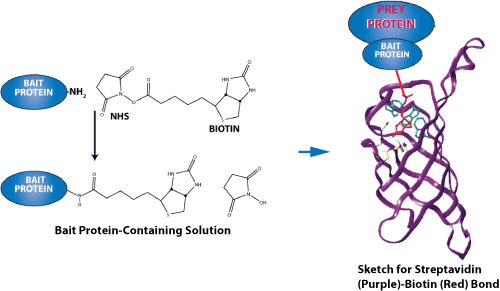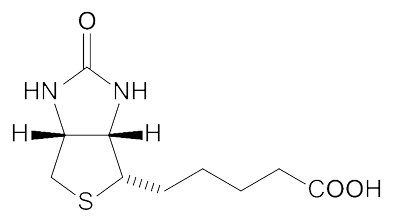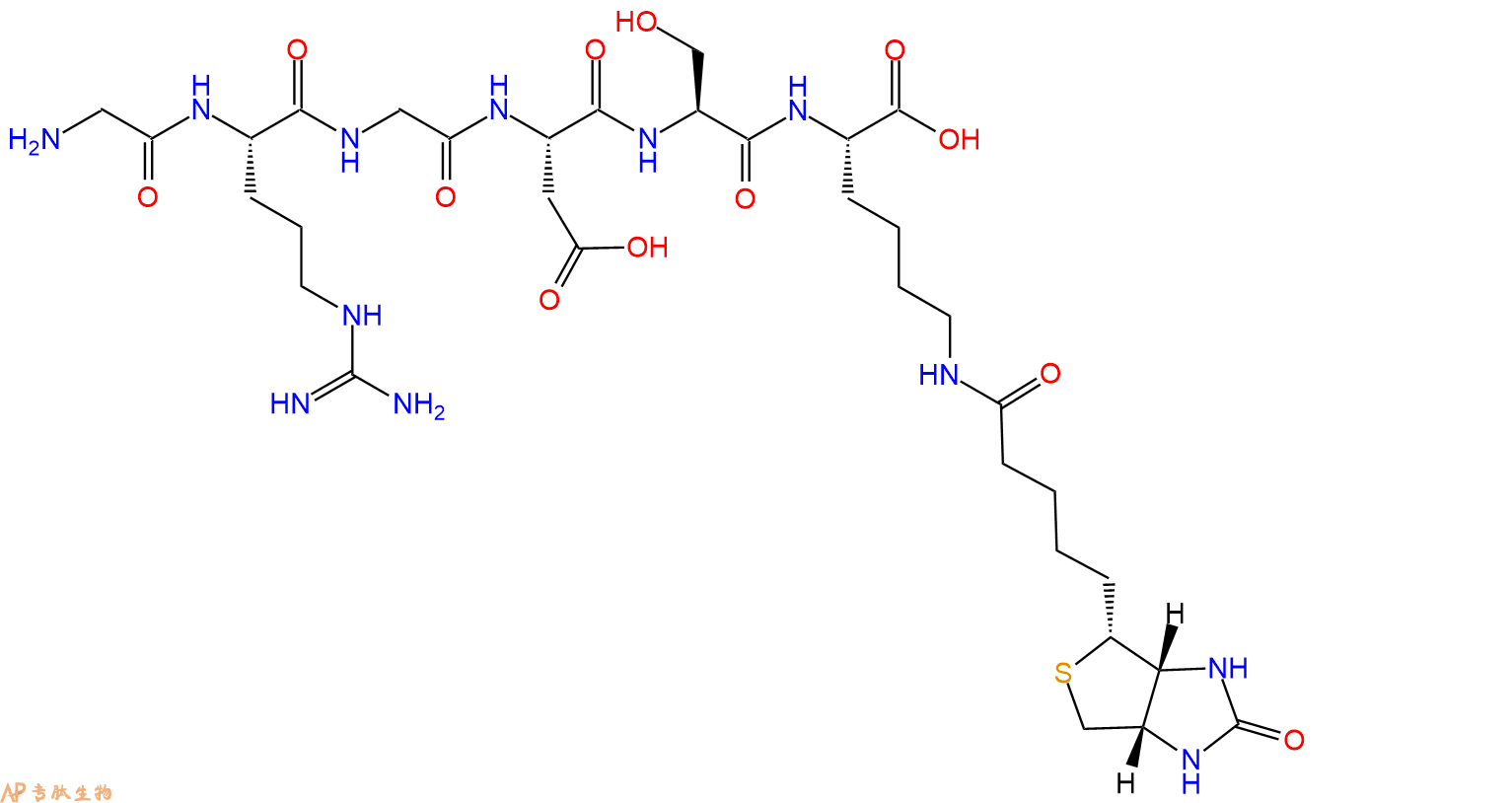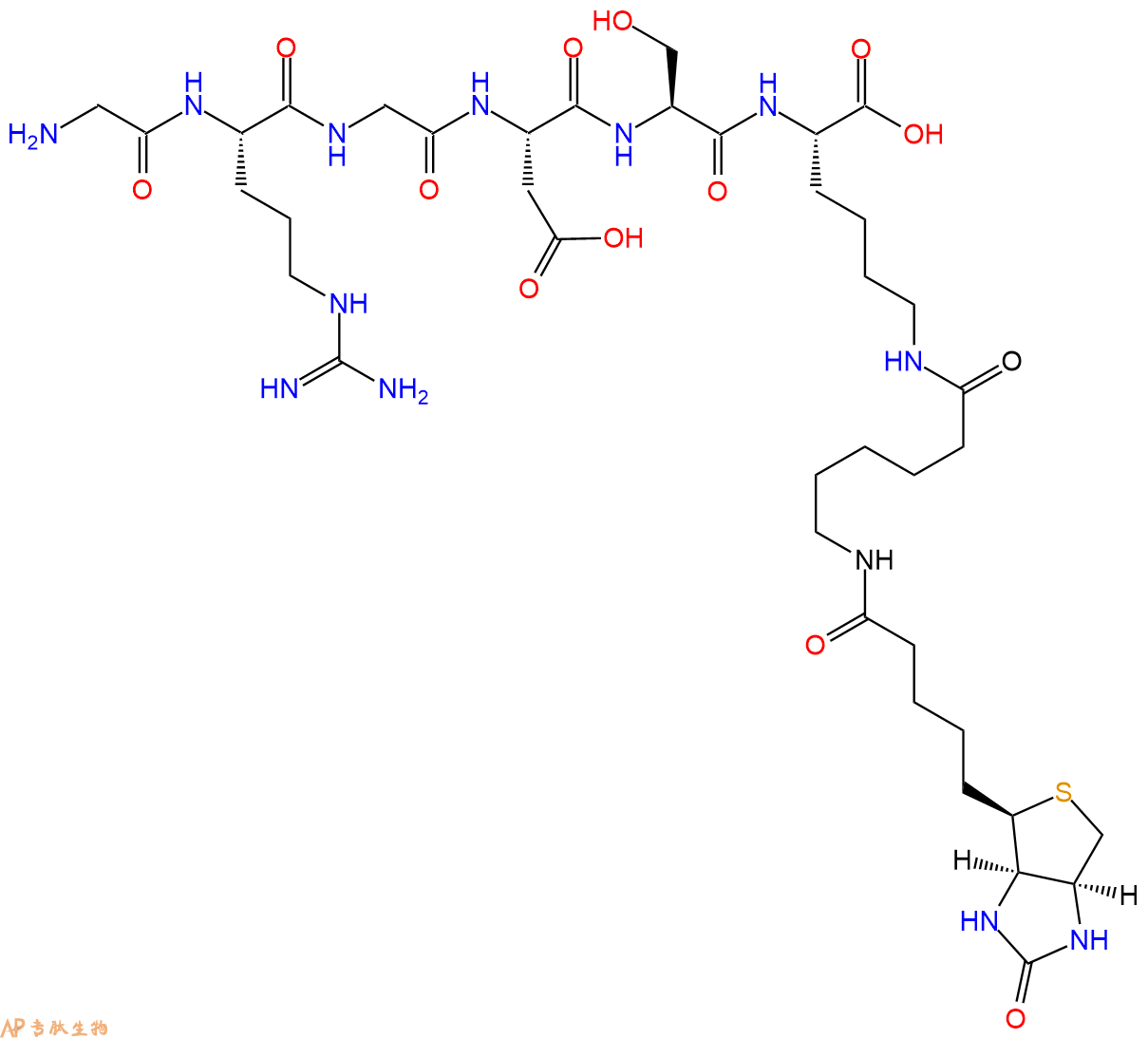
| 编号: | 434506 |
| 中文名称: | Biotin-β-Endorphin, human |
| 英文名: | Biotin - β - Endorphin, human |
| 单字母: | Biotinyl-YGGFMTSEKSQTPLVTLFKNAIIKNAYKKGE-OH |
| 三字母: | Biotinyl N端生物素标记 -Tyr酪氨酸 -Gly甘氨酸 -Gly甘氨酸 -Phe苯丙氨酸 -Met甲硫氨酸 -Thr苏氨酸 -Ser丝氨酸 -Glu谷氨酸 -Lys赖氨酸 -Ser丝氨酸 -Gln谷氨酰胺 -Thr苏氨酸 -Pro脯氨酸 -Leu亮氨酸 -Val缬氨酸 -Thr苏氨酸 -Leu亮氨酸 -Phe苯丙氨酸 -Lys赖氨酸 -Asn天冬酰胺 -Ala丙氨酸 -Ile异亮氨酸 -Ile异亮氨酸 -Lys赖氨酸 -Asn天冬酰胺 -Ala丙氨酸 -Tyr酪氨酸 -Lys赖氨酸 -Lys赖氨酸 -Gly甘氨酸 -Glu谷氨酸 -OHC端羧基 |
| 氨基酸个数: | 31 |
| 分子式: | C168H265N41O48S2 |
| 平均分子量: | 3691.28 |
| 精确分子量: | 3688.9 |
| 等电点(PI): | 11.06 |
| pH=7.0时的净电荷数: | 5 |
| 平均亲水性: | -0.066666666666667 |
| 疏水性值: | -0.43 |
| 消光系数: | 2980 |
| 标签: | 生物素标记肽(Biotinyl) 内吗啡肽(Endomorphin) 内啡肽(Endorphin) |

专肽生物合成用于蛋白质-蛋白质相互作用研究的生物素化肽。尽管生物素可以在 N 端或 C 端引入(通过赖氨酸残基),但我们建议使用 N 端修饰,因为它成本低、成功率高、周转时间短且易于操作。因为多肽合成是从 C 端到 N 端合成的,因此,N 端修饰是 SPPS步骤的最后一步,不需要额外的特定缩合步骤。相比之下,C 端修饰需要额外的步骤,并且通常更复杂。当然,原则上生物素可以定位在任何地方。

生物素可以通过多种不同的接头或间隔物与肽分离。尽管如此,还是建议包含一个灵活的间隔物,例如 Ahx(一个 6 碳接头),以使生物素标签更加稳定或灵活。
专肽生物在 N 端或 C 端提供生物素化:生物素-N 端、赖氨酸-生物素-肽中间和赖氨酸-生物素-C 端。
专肽生物还可以使用 Ahx 接头或长碳 (LC) 接头提供生物素化:生物素-Ahx-N 末端、Lys-Ahx-生物素-肽中间、Lys-Ahx-生物素-C-末端。

(生物素结构)
示例:
GRGDS在N端和C端标记生物素的结构展示。
1、GRGDS在N端标记生物素,不增加Ahx 接头

2、GRGDS在N端标记生物素,增加一个Ahx 接头

3、GRGDS在C端标记生物素,不增加Ahx 接头

4、GRGDS在C端标记生物素,增加一个Ahx 接头。

Definition
Endomorphin (EM)-1 and EM-2 are opioid tetrapeptides located in the central nervous system and immune tissues with high selectivity and affinity for the µ-opioid receptor 1.
Related Peptides
Opioid peptides and their G-protein-coupled receptors (d, ? and µ) are located in the central nervous system and peripheral tissues. The opioid system has been studied to determine the intrinsic mechanism of modulation of pain and to develop uniquely effective pain-control substances with minimal abuse potential and side effects. Two types of endogenous opioid peptides exist, one containing Try-Gly-Gly-Phe as the message domain (enkephalins, endorphins, dynorphins) and the other containing the Tyr-Pro-Phe/Trp sequence (endomorphins-1 and -2) 2.
Discovery
In 1997, Zadina et al., isolated Endomorphin 1 (EM1) and endomorphin 2 (EM2) from bovine brain, and reported them to be tetrapeptides having the highest specificity and affinity for the µ receptor of any endogenous substance so far described 3.
Structural Characteristics
Opioidmimetics and opioid peptides containing the amino acid sequence of the message domain of endomorphins (EMs), Tyr-Pro-Phe/Trp, have been found to exhibit unique binding activity. Endomorphin-1 (Tyr-Pro-Trp-Phe-NH2) and endomorphin-2 (Tyr-Pro-Phe-Phe-NH2) have high µ receptor affinity and remarkable selectivity 2. The proper spatial orientation and conformational restriction of the third aromatic ring is supposed to be crucial for the interaction of EMs with MOR (µ opioid receptor) 4.
Mode of Action
The endomorphins have the highest specificity and affinity to the µ receptor among all endogenous substance so far described. EM1 is more effective than the µ- selective analogue DAMGO in vitro and produces potent and prolonged analgesia in mice. EM2 (H-Tyr-Pro-Phe-Phe-NH2) also has a high affinity and selectivity to the µ receptor 2. The µ-opioid receptors are G protein-coupled receptors that play a pivotal role in the analgesic effects of opioid receptor agonists used clinically. Endomorphin-induced antinociception is mediated by spinal µ-opioid receptors 5.
Functions
Endomorphins have been implicated in a broad range of physiological functions including antinociceptive, cardiovascular, respiratory, digestive, rewarding, and endocrine responses 5. EM 1 and EM2 have significant naloxone-sensitive, vasodepressor activity 6. They modulate phagocytosis, chemotaxis and superoxide anion production by microglia 7. The analogues designed based on endomorphins may have therapeutic potential 8.
References
1. Coventry TL, Jessop DS, Finn DP, Crabb MD, Kinoshita H, Harbuz MS (2001). Endomorphins and activation of the hypothalamo-pituitary-adrenal axis. J Endocrinol., 169(1):185-193.
2. Okada Y, Tsuda Y, Bryant SD, Lazarus LH (2002). Endomorphins and related opioid peptides. Vitam Horm., 65:257-279.
3. Zadina JE, Hackler L, Ge LJ, Kastin AJ (1997). A potent and selective endogenous agonist for the mu-opiate receptor. Nature, 386(6624):499–502
4. Yu Y, Shao X, Cui Y, Liu HM, Wang CL, Fan YZ, Liu J, Dong SL, Cui YX, Wang R (2007).Structure-activity study on the spatial arrangement of the third aromatic ring of endomorphins 1 and 2 using an atypical constrained C terminus. ChemMedChem., 2(3):309-317.
5. Xie H, Woods JH, Traynor JR, Ko MC (2008). The Spinal Antinociceptive Effects of Endomorphins in Rats: Behavioral and G Protein Functional Studies. Anesth Analg., 106(6):1873-1881.
6. Champion HC, Zadina JE, Kastin AJ, Hackler L, Ge LJ, Kadowitz PJ (1997).. The Endogenous Mu-Opioid Receptor Agonists Endomorphins 1 and 2 Have Novel Hypotensive Activity in the Rabbit. Biochemi Biophysl Res Commun., 235(3) 567-570
7. Azuma Y, Ohura K, Wang PL, Shinohara M (2001). Endomorphins 1 and 2 modulate chemotaxis, phagocytosis and superoxide anion production by microglia. J Neuroimmunol., 119(1):51-56.
8. Huo XF, Ren WH, Wu N, Wang R (1998).The design and synthesis of endomorphins and their analogues. Chinese Science Bulletin., 46(13):1096-1099.
Definition
Endorphins are small neuropeptides that are produced by the body and act to reduce pain hence, the name endorphin (a shortened version of endogenous morphine). The term "enkephalin" (meaning literally "in the head") is also applied to endorphins, but usually refers to smaller molecules that have pain-relieving properties 1.
Related Peptides
There are 3 types of Endorphins:
Enkephalins: Met- and Leu-
Endorphins
Dynorphins
Endorphins are neuropeptides that can range from 2 to 39 amino acids in length. Neuropeptides are peptide molecules produced and released in the nervous system that act like transmitters 2. There are three different neuropeptide sequences including enkephalins, endorphins, and dynorphins 3
Discovery
In 1975, John Hughes and Hans W. Kosterlitz of the University of Aberdeen isolated two naturally occurring peptides in the brain that bound tightly to the opiate receptors and named them enkephalins. The endorphin molecule was subsequently isolated from the pituitary gland 4.
Structural Characteristics
Four distinct groups of endorphins have been identified to date. They have been termed: a-endorphin, a polypeptide with 16 residues; ß-endorphin, a polypeptide with 31 residues; ?-endorphin, a polypeptide with 17 residues; and S-endorphin, a polypeptide with 27 residues. These different types of endorphins, like all known polypeptide hormones, are synthesized in a "prepro" form that is one gigantic polypeptide with a signal sequence and additional sequences that are cleaved out during posttranslational maturation of the polypeptide. The most interesting example of this is the pituitary multihormone precursor termed pro-opiomelanocortin that contains the sequences for ß-lipotropin, melanocyte-stimulating hormone (MSH), endorphins, enkephalins, and adrenocorticotropic hormone (ACTH). After synthesis, this peptide is cleaved in the pituitary to generate ACTH and ß-lipotropin, while processing in the central nervous system produces endorphins and enkephalins, along with some other products 5.
Mode of Action
Receptors enable endorphins to perform their specific function. Opioid receptors are large protein molecules embedded in the semi-fluid matrix of the cell membrane of the receiving neuron. The surface of the receptor protein contains a region that is the precise size and shape to match the structure of the endorphin molecule. The endorphin molecule precisely fits into the specific receptor site. The binding of the neuropeptide with its specific receptor (opioid receptor) alters the three-dimensional shape of the receptor protein, thereby causing a neuron to be excited or inhibited6. As in the case of endorphins, inhibition of the neuron will reduce the release of substance P. In other words, the opioid receptor translates the precise messages encoded by the molecular structure of the endorphin molecule into a specific physiological response. Thus, receptors act as a control mechanism thereby regulating the function of endorphins 7.
Functions
Endorphins are not considered to be neurotransmitter molecules, but are instead classified as neuromodulatory, that is, they modify the action of neurotransmitters through a number of effects associated with pain or pleasure. Endorphins exhibit a number of neurological effects associated with the relief of pain. The administration of exogenous endorphins (those prepared outside the body) stimulates the release of many other hormones including prolactin, ACTH, and antidiuretic hormone. The analgesic effects of morphine are commonly believed to be caused by binding to receptor sites for endorphins, but few beneficial effects of treatment with exogenous endorphins have been reported. Early speculations concerning the function of endorphins suggested that they were natural painkillers that the body produced to alleviate pain in circumstances requiring an individual to continue functioning in spite of injury or stress. Examples of such situations might include childbirth, exercise, and combat. Several procedures that treat chronic pain (acupuncture, direct electrical stimulation of the brain and even hypnosis) may act by inducing the release of enkephalins or endorphins in the brain and spinal cord. This hypothesis is based on the finding that the effectiveness of treating pain implemented by these procedures is blocked by administration of naloxone, a drug that specifically blocks the binding of morphine to the opiate receptor 1.
References
Book: Textbook of Biochemistry: With Clinical Correlations by Devlin TM.
Book: Animal Physiology by Eckert R.
Book: Neurobiology by Shepherd GM.
Book: The Brain by Iverson L.
Book: Molecular Expressions: Exploring the World of Optics and Microscopy Michael WD.
Book: Neural and Integrative Animal Physiology by Prosser CL.
Book:. Neuroscience by Barker RA





